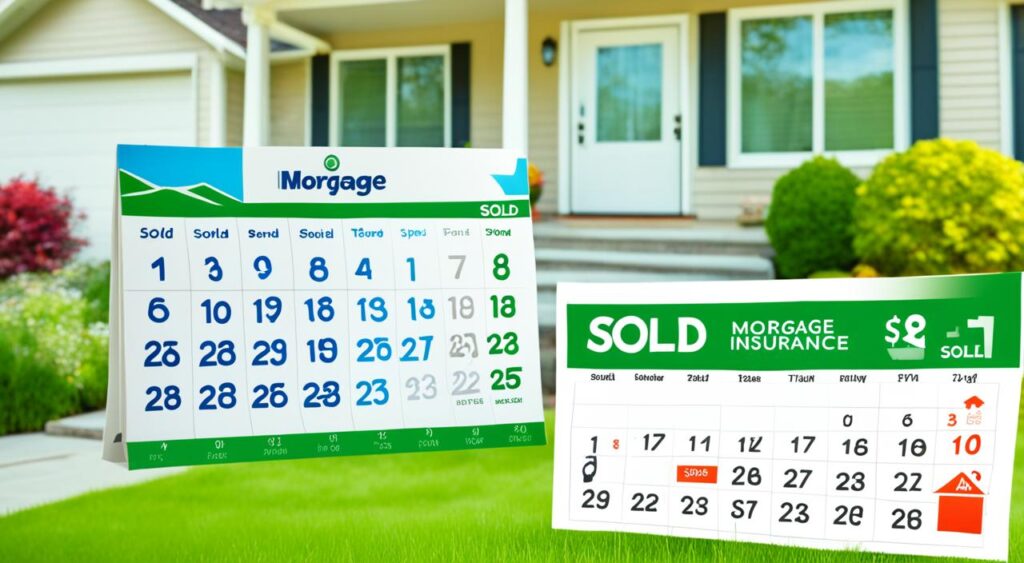Mortgage insurance is key when buying a home, especially with a down payment under 20 percent. It makes lenders less hesitant to give out loans, which aids those who wouldn’t usually meet home loan requirements. Yet, insurance adds to the loan’s total cost. Knowing about mortgage insurance, its types, and how it affects what you pay each month is crucial for wise home purchasing decisions.
Key Takeaways
- Mortgage insurance is typically required for borrowers making a down payment of less than 20% on conventional loans, as well as on FHA and USDA loans.
- Mortgage insurance protects the lender by lowering the risk of making a loan, but it increases the overall cost of the loan for the borrower.
- There are different types of mortgage insurance, including private mortgage insurance (PMI), FHA mortgage insurance premium (MIP), and USDA and VA guarantee fees.
- The cost of mortgage insurance varies depending on factors such as loan type, loan amount, down payment, and credit score.
- Borrowers may be able to cancel private mortgage insurance once they’ve built up enough equity in their home.
What Is Mortgage Insurance?
Mortgage insurance helps lenders and titleholders if the borrower can’t pay, dies, or breaks the mortgage terms. There are a few kinds of it. These include private mortgage insurance (PMI) and mortgage title insurance.
Definition and Purpose
Mortgage insurance’s main goal is to cover the lender’s loss in certain tough cases. It helps protect lenders when they lend to those with low down payments or higher default risks. This way, it lets more people buy homes.
Types of Mortgage Insurance
The main types are:
- Private Mortgage Insurance (PMI): It’s needed for conventional loans if your down payment is under 20%.
- Qualified Mortgage Insurance Premium (MIP): Federal Housing Administration (FHA) loans require this. It has upfront and annual costs.
- Mortgage Title Insurance: It shields the lender and buyer from title issues like ownership fights or hidden charges.
Each type is key in making it easier for homebuyers with small down payments. It also ensures the lender’s safety.
Private Mortgage Insurance (PMI)
If you get a conventional loan, your lender could set up PMI with a private company. PMI protects the lender if you can’t make your mortgage payments.
When Is PMI Required?
If your down payment is less than 20 percent on a home, you’ll need to pay for PMI. This makes it easier for buyers with low down payments to get a loan.
Costs and Calculations
The amount you pay for PMI depends on your down payment and credit score. Those with better credit usually pay less for PMI than on FHA loans. You’ll pay PMI each month, with possibly no first payment at closing.
Lenders use your loan-to-value ratio and credit score to figure out PMI. For instance, if you have a 90% LTV and a 760 credit score, you might pay 0.58% of your loan amount monthly.
Canceling PMI
When you reach 20% equity in your home, you can ask to stop paying PMI. This could reduce your monthly mortgage and save you money. But, the steps to end PMI can differ by lender, so know your policy well.
FHA Mortgage Insurance Premium (MIP)

If you choose a Federal Housing Administration (FHA) loan, you must pay for FHA mortgage insurance premiums (MIP). This is a must for all FHA loans, no matter your credit score. Only if you pay less than five percent as a down payment, the price will be a tad higher.
Upfront MIP
Part of your closing costs includes the upfront MIP. It’s about 1.75% of your loan amount. You can include this cost in your mortgage, which will increase your loan amount and what you pay over time.
Annual MIP
FHA borrowers pay for annual mortgage insurance too, part of their monthly payments. This yearly fee is between 0.45% to 1.05% of the loan balance. How much you pay depends on your loan amount, term, and the initial loan-to-value ratio.
You’ll keep paying this premium as long as you have the loan. But if your loan-to-value ratio drops to 78%, you might stop paying for MIP.
USDA Guarantee Fee
If you choose a USDA loan, the insurance program works like the FHA’s but is usually cheaper. You’ll pay a fee at closing and an insurance fee each month.
You can add the upfront fee to your loan, just like with an FHA loan. But, this means you’ll pay more over time.
| Upfront Guarantee Fee | 1.00% of the total loan amount |
|---|---|
| Annual Guarantee Fee | 0.35% of the remaining loan balance |
The upfront fee can be part of your mortgage, but you’ll pay the annual fee monthly. This setup aims to help those with modest incomes buy homes in certain areas.
VA Funding Fee
If you get a VA-backed loan, you won’t need to pay monthly mortgage insurance. Instead, there’s an upfront “funding fee.” This fee changes depending on your military service, your down payment, and more.
| Loan Type | Down Payment | First-Time Use | Subsequent Use | Disabled Veteran |
|---|---|---|---|---|
| Purchase | 0% | 2.3% | 3.6% | 0% |
| Purchase | 5% or more | 1.65% | 1.65% | 0% |
| Refinance | 0% | 2.3% | 3.6% | 0.5% |
This funding fee is a one-time charge that helps support the VA home loan program. You can pay it upfront or add it to your total loan amount. The fee is not required for certain disabled veterans.
Mortgage Insurance
Mortgage insurance protects the lender, not you, in case you miss payments. Missing payments can lower your credit score and lead to losing your home. If the sale of your home doesn’t cover the mortgage, the insurance pays the rest. This ensures the lender gets all their money back.
How It Protects Lenders
Mortgage insurance lowers the financial risk for lenders. They can offer loans with low down payments. If the borrower can’t pay, the insurance helps cover the lender’s lost money. This way, the lender won’t lose all they’ve invested.
Advantages for Borrowers
For borrowers, mortgage insurance means they can buy a home with a small down payment. Often, this is less than 20% of the home’s value. It makes buying a home easier, especially for those new to buying or with little savings. Also, it helps some borrowers get a loan they wouldn’t qualify for otherwise.
Disadvantages for Borrowers
Mortgage insurance means an extra cost on your monthly mortgage. This can make owning a home more expensive than expected. It doesn’t directly help the borrower since it’s for the lender’s protection if you can’t pay.
Factors Affecting Mortgage Insurance Costs

Many things decide how much mortgage insurance costs. Knowing these can help people pay less.
Loan Type
Different loan types mean different insurance costs. For instance, FHA loans need more insurance than conventional loans. But, VA loans don’t need any mortgage insurance.
Loan Amount
The size of your loan affects insurance costs, too. Bigger loans mean higher premiums. That’s because the risk to the lender is more.
Down Payment
How much you pay upfront matters. A bigger down payment means lower insurance costs. Paying 20% of the home’s value or more can stop mortgage insurance payments.
Credit Score
Your credit score also plays a big role. Those with high scores get lower insurance rates. But if your credit is low, you might pay more.
Alternatives to Mortgage Insurance

Mortgage insurance is often needed by homebuyers. Yet, you can avoid this extra expense by exploring some key alternatives. Larger down payments and piggyback loans are two good options.
Larger Down Payment
Avoiding mortgage insurance can be done with a 20% down payment. It shows lenders you’re heavily invested in the home. This makes it less risky for them to loan you money. If you can put down 20%, you might get away with not needing mortgage insurance.
Piggyback Loans
Consider a “piggyback” loan, which comes in forms like “80-10-10” or “80-20”. You get an 80% first mortgage, a second mortgage (or home equity loan) for 10-20%, and make a 10-20% down payment. This setup stops mortgage insurance being required and keeps your initial down payment lower.
While these methods can cut down on mortgage insurance costs, they might require more money up front. Also, they involve some extra steps in your financing. It’s wise to look closely at your options and see what fits best with your financial goals.
When Can You Stop Paying Mortgage Insurance?

Once there’s enough equity in your home, you might not need mortgage insurance. The rules for canceling it might change based on your loan. But, you usually need to have:
- At least 80% of your home paid for with your mortgage.
- Be on time with your mortgage for 24 months.
- Any extra needs from your lender or the type of insurance you have (like FHA or VA).
If you have a conventional loan, you can usually stop PMI when you reach an 80% LTV. For FHA loans, after 11 years, you might get your upfront fee back once your LTV drops to 78% or lower. VA loans, however, don’t have monthly insurance. But, they do come with an upfront fee.
It’s smart to keep an eye on your equity and when you can cancel insurance. This might save you a lot of money in the long run.
Also Read: Insuring Your Legacy: The Value Of Life Insurance Planning
Conclusion
Mortgage insurance is key for those buying a home with low down payments. It protects lenders if a borrower can’t pay back the loan. This helps more people buy homes, even if it adds to the cost.
There are types like PMI, MIP, guarantee fees, and VA funding fees to know. It’s important to understand these to pick the best mortgage for you. Things like loan type, amount, down payment, and credit score affect the insurance cost.
Mortgage insurance is really vital for getting a home. Knowing all about it and comparing your options can lead to a smart choice. This way, you can reach your homeownership dream while being financially secure.
FAQs
Q: How does mortgage insurance work?
A: Mortgage insurance protects a mortgage lender in case a borrower defaults on their loan. It is typically required for borrowers who make a down payment of less than 20% on a home.
Q: How do I pay for private mortgage insurance (PMI)?
A: Private mortgage insurance (PMI) can be paid monthly as part of your mortgage payment, in a lump sum upfront, or as a combination of both.
Q: What are the types of private mortgage insurance?
A: There are different types of private mortgage insurance, including borrower-paid and lender-paid PMI, as well as split-premium and single-premium options.
Q: How can I avoid paying PMI?
A: You can avoid paying PMI by making a down payment of 20% or more on a home purchase, getting a VA loan, or exploring lender-paid mortgage insurance options.
Q: How can I get rid of PMI?
A: To get rid of PMI, you can request to cancel it once you have paid down your mortgage balance to 80% of the home’s original value. Another option is to refinance your mortgage to eliminate PMI.
Q: What is the cost of PMI?
A: The cost of PMI varies depending on factors such as the size of your down payment, loan amount, and credit score. On average, PMI can range from 0.3% to 1.5% of the original loan amount per year.
Q: What is a mortgage loan and how does mortgage insurance make it possible?
A: A mortgage loan is a type of loan used to purchase a home, where the lender provides funds to the borrower. Mortgage insurance makes it possible for borrowers with smaller down payments to qualify for a mortgage by reducing the risk for lenders.
Source Links
- https://www.consumerfinance.gov/ask-cfpb/what-is-mortgage-insurance-and-how-does-it-work-en-1953/
- https://www.investopedia.com/terms/m/mortgage-insurance.asp
- https://www.bankrate.com/mortgages/what-is-mortgage-insurance/





